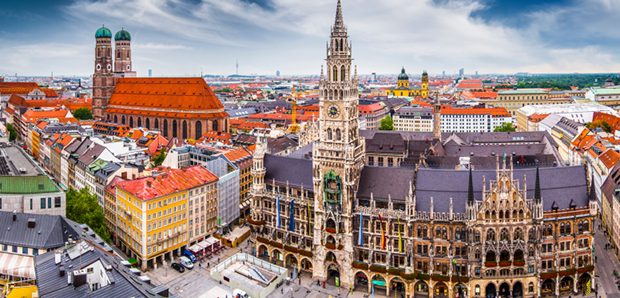Master's project at the Max Planck Institute - Garching, Germany
Report by Federico Pesamosca. Powered by FuseNet
 My newly gained insights in the energy sector during my Bachelor in Energy Engineering at the Politecnico di Milano moved me towards a specialization in the field of nuclear fusion for my Master’s degree. I really wanted to know more about the opportunities nuclear fusion could offer in the future. This has driven me to become gradually more engaged in this field and especially my visit to the CEA Cadarache research center and the future ITER site in Saint-Paul-lès-Durance (France), has awakened my passion for fusion. So, for my Master’s thesis, what could have been better than an internship within a research center to get more insight into this promising solution for future energy issues?!
My newly gained insights in the energy sector during my Bachelor in Energy Engineering at the Politecnico di Milano moved me towards a specialization in the field of nuclear fusion for my Master’s degree. I really wanted to know more about the opportunities nuclear fusion could offer in the future. This has driven me to become gradually more engaged in this field and especially my visit to the CEA Cadarache research center and the future ITER site in Saint-Paul-lès-Durance (France), has awakened my passion for fusion. So, for my Master’s thesis, what could have been better than an internship within a research center to get more insight into this promising solution for future energy issues?!
Taking the initiative, I started my investigation and I discovered the various opportunities existing throughout Europe for such an internship. After a short while, I got a proposal to join a project at the Plasma Edge and Wall division of the Max Planck Institute for Plasma Physics in Garching, near München (Germany). This historical institute, founded in 1960, has always been a cutting-edge research center and nowadays it is strongly integrated in the European Fusion Program. At its Garching site, ASDEX Upgrade is operated, which is a tokamak similar to ITER, but smaller. The ASDEX-facility allows fusion scientists to study the physics of plasma and the interaction of the fourth state of matter with its surrounding materials, therefore being a great benchmark to make predictions about the expected plasma behavior in ITER.
Project
My project was originally titled “Transition from flow/turbulence to type-III ELM limit cycles during the I-phase”. The only thing I understood about this at the beginning is that physicists really love their acronyms! However, after I started my internship, the steep learning curve combined with the stimulating environment of Max-Planck-IPP allowed me to quickly comprehend the issue and contribute actively.
ITER will operate in H-mode, reached from the L-mode by making sure that external heating power exceeds a certain threshold. During the following transition, the I-phase takes place. Recent experiments at ASDEX Upgrade have characterized the L-H transition, observing low amplitude oscillations at the edge which evolved into macroscopic instabilities, called ‘Edge Localized Modes’ or ‘ELMs’. These ELMs are able to degrade the confinement, but they are also able to control the particle inventory inside the tokamak. In order to motivate these observations, I developed a dynamical model together with my supervisor, Dr. Peter Manz, which is able to reproduce the observed plasma evolution, starting from fundamental fluid equations. This work has required a lot of creativity and intuition, but also careful steps and strong analytical skills during the derivation of the model. Therefore, it has been a very challenging and motivating experience. The numerical simulations that I performed using the newly derived model, have been a great way to gain more insight in the physics of L-H transitions. Despite their inherent simplicity, the results were promising and it has been possible to compare them to the experimental data of ASDEX Upgrade.

Life outside the office
Life of course was not limited to the desk of my office (despite it was a really nice office!). Approximately 700 people are working at Max-Planck-IPP and there was a lot to see and learn outside there. During my seven months internship, I could attend different events organized within the institute. Some were education oriented, for instance, the Summer University for Plasma Physics and Fusion Research, which was being held especially for physics and engineering students who have passed their Bachelor. Furthermore, I have followed some Advanced Courses in Fusion Plasmas Physics for the European PhD Network in Fusion Science and Engineering, and I have attend the H-mode Workshop that allowed me to understand the current status of the research on the topic of my Master’s thesis. Both of them, allowed me to get in touch with specialists from all over the world. Next to that, I have been guiding high school classes at the IPP Garching, showing them around at the institute and the torus hall, while explaining them the principles of thermonuclear controlled fusion. This has really been a fun experience, since it allowed me to meet many other people and move freely throughout the facilities, learning much more than what I could “teach”.
Finally, the period of my internship was the best to be in Munich: I could enjoy the Oktoberfest, the Christmas Markets and the Starkbierzeit. Moreover, I could also enjoy the world-famous Biergartens of the city at any moment!
Nevertheless, I have dedicated most of my time to my main task, and my effort was well-rewarded: my supervisor gave me the opportunity to present the outcome of our work during a poster session at the DPG Spring Meeting 2016 in Hannover (Germany), right before the end of my stay in Bavaria.
In conclusion, this was a paramount experience for my formation and my life, and I am thankful to Fusenet for supporting me and making this possible. To all the students out there: be curious! There is so much to do and to learn in fusion and now it is the best moment to join!
